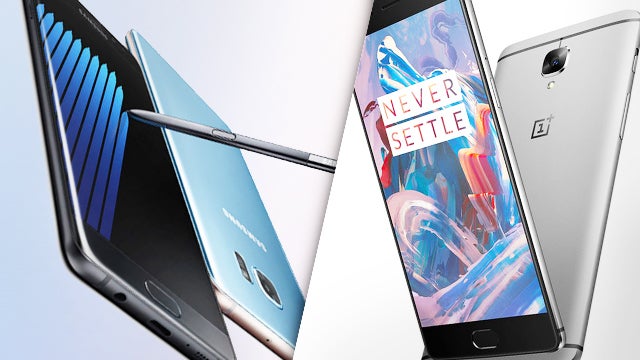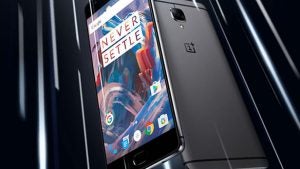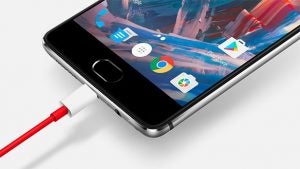Galaxy Note 7 vs OnePlus 3: Which is best?

Galaxy Note 7 vs OnePlus 3: Which smartphone is king in the flagship face-off between South Korea’s Samsung and China’s OnePlus?
Now official and available to pre-order, the Samsung Galaxy Note 7 is a supercharged powerhouse that takes no prisoners. When it comes to raw hardware, it’s a phone that’ll be tough to match.
Unless you’re the OnePlus 3, that is. With oodles of computing heft and a price tag that undercuts almost everyone, it’s a phone that every discerning buyer should consider.
So which is better: Top-of-the-range Samsung fare, or the formidable (and budget-friendly) OnePlus 3? Read on to find out.
Watch: Samsung Galaxy Note 7 review
Related: Best Android Smartphones 2016
Galaxy Note 7 vs OnePlus 3 – Design
Galaxy Note 7: 169g | 153.5 x 73.9 x 7.9mm
OnePlus 3: 158g | 152.7 x 74.7 x 7.4mm
The Galaxy Note 7 is an impressive-looking bit of kit. Just like the Galaxy S7, it flaunts a shiny glass rear that looks gorgeous. The downside is that glass is notoriously fragile, so don’t drop it. We have a Galaxy S7 and a Galaxy S7 Edge in regular use in the office, both of which have cracked since their very recent launch.
It’s also worth noting that this is the first Note handset to be available with a dual-curved-edge display. That’ll please design hounds or fans of the Galaxy S6/S7 Edge, but others may not be so impressed by its limited functionality. Nevertheless, it’s clear that the Galaxy Note 7 is one of the most attractive phones on the market today.

The OnePlus 3 is smaller, thinner and weighs less than the Galaxy Note 7. It’s also the most attractive OnePlus phone yet. It’s basically the same as the OnePlus 2 on the front – shiny, black and largely inoffensive. There’s a fingerprint scanner below the screen, and a front-facing camera above.
The back, however, has seemingly borrowed much from the rival HTC One M9. It’s a more premium approach than we’ve seen from OnePlus previously, and gels well with the company’s shift from a lowly start-up to a serious industry contender.
It’s hard to say which handset is more attractive; it depends which one suits your tastes. I’m slightly more partial to the Galaxy Note 7, but if you’re butterfingered, the less crack-able OnePlus 3 could be the perfect purchase for you.

Galaxy Note 7 vs OnePlus 3 – Display
Galaxy Note 7: 5.7-inch | 1,440 x 2,560 pixels | 518ppi | Corning Gorilla Glass 5 | Super AMOLED
OnePlus 3: 5.5-inch | 1,080 x 1,920 pixels | 401ppi | Corning Gorilla Glass 4 | Optic AMOLED
Many speculated that the Note 7 would finally bring 4K smartphone screens into the mainstream, but Samsung has instead retained its tried-and-tested QHD Super AMOLED display. It’s gorgeous, colourful and almost certainly one of the best panels available today.
By contrast, the OnePlus 3 has a 5.5-inch display, which is also pretty large – the same as the one on the iPhone 6S Plus, in fact. It’s boasts a Full HD screen resolution, which is the least you’d expect from a high-end phone in 2016. At this size, you’ll struggle to notice pixel density – 401 pixels per inch, in this case – beyond Full HD.
So what’s the difference between Super AMOLED and Optic AMOLED? Not very much, actually. They’re both basically the same display, and they’re both built by Samsung. However, OnePlus has made software modifications to the bog-standard Super AMOLED screen, adjusting the colour temperature and contrast of the display, specifically with the goal of improving viewability outdoors.
Until we see both handsets side by side, we can’t say for sure which phone screen is better. But on paper, the Note 7 wins. And based on what we’ve seen of the Note 7 so far, we’d say it’s winning in real life too.

Related: Best Android Apps 2016
Galaxy Note 7 vs OnePlus 3 – Hardware
Galaxy Note 7 (US/Japan): Qualcomm MSM8996 Snapdragon 820 | Dual-core 2.15GHz Kryo and dual-core 1.6GHz Kryo processors | Adreno 530 GPU | 64GB storage | 4GB RAM
Galaxy Note 7 (China): Qualcomm MSM8996 Snapdragon 820 | Dual-core 2.15GHz Kryo and dual-core 1.6GHz Kryo processors | Adreno 530 GPU | 64GB storage | 6GB RAM
Galaxy Note 7 (Other regions): Samsung Exynos 8890 Octa | Quad-core 2.3GHz Mongoose and quad-core 1.6GHz Cortex-A53 processors | Mali-T880 MP12 | 64GB storage | 4GB RAM
OnePlus 3: Qualcomm MSM8996 Snapdragon 820 | Dual-core 2.15GHz Kryo and dual-core 1.6GHz Kryo processors | Adreno 530 GPU | 64GB storage | 6GB RAM | Fingerprint scanner | Mute button
Whatever version of Note 7 you get, it’s going to be powerful. Both the Snapdragon 820 and Exynos 8890 are built on a highly efficient 14nm manufacturing process, which means you should get computing heft without significant power drain.

But the OnePlus 3 also uses the Snapdragon 820, so don’t discount its capabilities either. And, excitingly, it features 6GB of RAM – although how well this is utilised remains open for debate.
We’ll have to wait for proper Note 7 benchmarks before we can plonk the performance crown down on either of these phones.
Galaxy Note 7 vs OnePlus 3 – Software
Galaxy Note 7: Android 6.0.1 – skinned with TouchWiz (planned upgrade to v7.0 Nougat)
OnePlus 3: Android 6.0.1 – skinned with custom-built Oxygen OS
Neither of these devices run on stock Android, so Nexus enthusiasts may be put off by the tweaks. Fortunately, OnePlus kept the changes to a minimum with its custom-built Oxygen OS: a few tweaks to menus and options, new colour themes and a quick-access panel, for example. Most additions are useful, but you can live without them, and they’re unlikely to influence your purchasing decision.
Samsung, by contrast, overlays a skin that’s far less subtle. The company’s TouchWiz software has been reviled in years gone by for its overbearing style, but the most recent versions have improved significantly. Gone are the days of bugs and glitches, stuttering animations and hideous colours – it’s slick, and certainly on par with iOS.
The bright side here is that neither Samsung nor OnePlus is offering a bad software experience. You’ll probably be happy either way.
Watch: Is Note 7 better than S7?
Galaxy Note 7 vs OnePlus 3 – Camera
Galaxy Note 7: Primary – 12-megapixel with Dual Pixel tech | f/1.7 | phase-detection autofocus | OIS | LED flash | 1/2.5-inch sensor | 1.4um pixel size | Auto HDR || Secondary – 5-megapixel | f/1.7
OnePlus 3: Primary – 16-megapixel | f/2.0 | phase-detection autofocus | OIS | LED flash | 1/2.8-inch sensor | 1.12um pixel size | HDR || Secondary – 8-megapixel | f/2.0
We know what you’re thinking: the megapixels are higher on the OnePlus 3! Sure, but Samsung’s using a different (and arguably better) type of camera. The Galaxy Note 7 has repurposed the Galaxy S7’s shooter, which has widely been lauded as the best smartphone camera to date.
So what is Dual Pixel tech? Basically, every single pixel on the image sensor has two photodiodes instead of one. The biggest advantage of this is faster focusing. That’s because when you’re taking a photo with an iPhone, 5-10% of the pixels are used for focusing, but with the Galaxy Note 7 every single pixel is able to contribute.
We’re still waiting on the full review, but we’d be very surprised if the OnePlus 3’s camera managed to trump the Note 7’s overall, since it’s basically the same shooter as the one featured on the Galaxy S7.

Galaxy Note 7 vs OnePlus 3 – Battery
Galaxy Note 7: 3,500mAh battery | Non-removable
OnePlus 3: 3,000mAh battery | Non-removable
The Note 7 features a 3,500mAh battery, which is bigger than the one built into the OnePlus 3. That’s good news, as the phone is using a higher-resolution display, so battery life shouldn’t be a big issue for either phone. Of course, that depends on other factors such as OS optimisation and processor efficiency. Fortunately, the chips the phones use, and the OS they run on, are very up to date, so battery life should be stellar all round.
Related: What is Dash Charge?
Galaxy Note 7 vs OnePlus 3 – Price
Galaxy Note 7: £749
OnePlus 3: £329
This is where the OnePlus 3 smashes its Samsung rival. The OnePlus 3 is less than half the price of the Samsung Galaxy Note 7, and that’s even factoring in the post-Brexit price hike.
While Samsung’s Galaxy Note 7 has generally won out on specs, the OnePlus 3 is miles ahead on value for money. After all, the Note 7 is one of the most expensive phones available right now, and the OnePlus 3 is one of the cheapest – for a flagship, anyway.

Perhaps the only advantage of buying from Samsung is that you’re getting a better corporate infrastructure, so if something goes wrong, it’s easier to get some recourse or compensation. OnePlus has a questionable track record when it comes to customer service, so remember that you (generally) get what you pay for. There’s no shortage of hard-done-by customers on OnePlus forums.
Related: Galaxy S7 vs OnePlus 3
Galaxy Note 7 vs OnePlus 3 – Summary
Pending our full review, it’s still fair to say that the Galaxy Note 7 is almost certainly one of the best phones available right now. It’s powerful, it’s attractive and it’s seriously feature-packed.
But for the price of a Galaxy Note 7, you could buy two OnePlus 3 handsets and still have some spare change. So while the Galaxy Note 7 may be a slightly better proposition on paper, the price changes all of that.
If you want the best of the best of the best, then you won’t be disappointed by the Galaxy Note 7 – but you’ll have to accept the mind-boggling price tag. If you’re happy to settle for a supercharged OnePlus smartphone (without all the Samsung customer service trimmings), then you could save a boat-load of cash and still walk away with an impressive flagship smartphone.
Related: OnePlus 3 vs Nexus 6P
Watch The Refresh: The best tech gossip and reviews every week
Which do you prefer: the Galaxy Note 7 or the OnePlus 3? Let us know in the comments.


